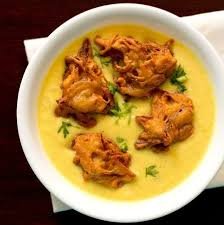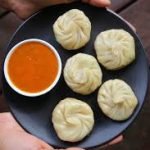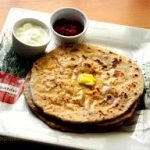A Kadhi recipe that is a family heirloom recipe and tastes super delicious. This fabulous Kadhi Pakora is my mother-in-law’s treasured recipe of making the traditional Punjabi Kadhi with onion pakora. Here the crispy onion fritters are dunked in a spiced, savory, tangy yogurt sauce. A recipe she has been making for ages and loved by all of us.
About Kadhi Recipe
The Hindi word “Kadhi” denotes a yogurt sauce that has been slow-cooked for quite some time. The word “pakora” means fritters made from gram flour (besan). In this recipe, the fritters are made with savory, spiced batter made with onions, gram flour and seasonings.
There are many variations of making kadhi in North and Western Indian cuisines. Even though the spices or herbs added are different, but the yogurt sauce is mostly thickened with gram flour (called besan in Hindi).
Gram flour is made from skinned black chickpeas and has a nutty flavor. The curd that is used to make kadhi is sour curd. As a result, this dish has a sour, spiced and creamy taste.
You will find that each state and region have their own ways of making dahi besan kadhi. So we have Maharashtrian Kadhi, Rajasthani Kadhi, Gujarati Kadhi, Sindhi Kadhi and so on.
The Punjabi Kadhi is different from the other regional variations of kadhi. It is thicker and creamier than other variations which have a slightly thinner consistency.
The herbs and spices used in the recipe are also different. The onion pakora offers a lot of texture and balances the creaminess of the yogurt sauce.
I often make Kadhi pakora, but I just could not manage to take step-by-step photos and that is why it took me so long to share this delicious Punjabi kadhi recipe.
We love kadhi, be it with or without pakora. When we serve Punjabi kadhi pakora with steamed rice or jeera rice, we call it kadhi chawal – where chawal is the Hindi word for rice.
You can also have kadhi with roti but we prefer to have it with rice. Kadhi Chawal and Rajma Chawal are a staple and much-loved food in Punjabi homes.
How to make Kadhi Pakora
This is again one of those recipe posts, where there are maximum pictures. Since I am presenting a step-by-step photo guide, I will first begin with making the curd slurry, then making the onion pakora and then finally with the making of the kadhi pakora.
Make Curd Slurry
1. In a bowl take 1.5 cups sour curd or about 375 grams of curd. Whisk it well till smooth.
2. Add 8 tablespoons of gram flour (besan), ½ teaspoon red chilli powder, ½ teaspoon turmeric powder, ½ teaspoon garam masala powder and 1 teaspoon salt to the whisked curd.
3. Stir and mix everything again.
4. Add 3 cups water and stir again.
5. Stir very well to make a smooth mixture without lumps. If there are lumps, then break them with a wired whisk or a spatula or with your fingers. Set the curd slurry aside.
You can use a blender to make this mixture, but make sure you don’t over do it. You will get butter instead of a smooth blended curd.
Make Pakora For Kadhi
1. Take 1 cup gram flour (besan) in a bowl and add the following ingredients:
- ½ teaspoon ajwain (carom seeds)
- ½ teaspoon red chili powder or cayenne pepper
- ½ teaspoon garam masala powder
- ⅔ teaspoon salt or as required
2. Add 1 cup thinly sliced onions. About 2 medium to large onions, sliced, approx 150 grams of onions.
3. Mix everything well and keep aside covered for 30 minutes.
4. This will allow the onions to release their water in the mixture. Depending on the water content in the onions, the mixture will become very moist or just about moist. Here’s a photo of the onions after 30 minutes. Mix again.
4. Then accordingly add water as required to make a thick batter. I added ¼ cup water. You can also skip adding water if the mixture is too moist.
6. Heat oil for deep frying in a pan or kadai. You can use any neutral-flavored oil with a high smoking temperature or mustard oil.
When the oil becomes medium hot, with a spoon drop the pakora batter in the oil.
7. When the pakora are partly cooked, then turn over with a slotted spoon and continue to fry the other side.
8. Fry till the pakora are crisp and golden turning over a couple of times for even cooking.
9. Remove the fried pakora and place them on a kitchen paper towel so that extra oil is absorbed. Fry the pakora in batches this way. When done keep all of them aside.
Make Kadhi Recipe
1. In another pan or kadai, heat 2 tablespoons of mustard oil. Make sure to use a large bottomed pot so that while cooking, the kadhi does not spill.
If you don’t have mustard oil, feel free to use any neutral-flavored oil. But the traditional Punjabi kadhi has mustard oil.
2. Add 1 teaspoon cumin seeds, 8 to 10 fenugreek seeds (methi seeds) and a generous pinch of asafoetida (hing).
Allow the cumin seeds to crackle and the fenugreek seeds to change their color. Fry on a low flame, so that these spices do not get burnt.
3. Add ⅓ cup chopped onions. Stir and saute for 3 minutes on low to medium-low heat.
4. Then add 1 tablespoon chopped ginger, ¾ to 1 tablespoon chopped garlic and 2 green chillies, chopped. Stir and sauté for a minute.
5. Now add 8 to 10 curry leaves, 2 dry red chilies (halved or broken).
6. Stir and sauté for a minute on a low heat.
7. Then add the curd slurry.
8. Stir very well.
9. Increase the flame to medium and bring the kadhi to a boil. Keep on stirring often so that the bottom does not get browned. Time taken to cook kadhi will be around 14 to 16 minutes.
10. After it comes to a boil, then lower the heat and simmer it for a further 6 to 7 minutes. Do stir at times.
The kadhi will thicken as it cooks and simmers. If it becomes too thick, then add some hot water.
11. In the below photo, the kadhi is ready.
Make Kadhi Pakora
12. Now add the onion pakora to the kadhi. Stir gently.
13. Cover with a lid and let the onion pakora be soaked in it for 8 to 10 minutes.
14. Lastly, sprinkle some garam masala powder on the Punjabi Kadhi.
15. Garnish with coriander leaves and serve Punjabi Kadhi Pakora hot with steamed rice or jeera rice, topped with few teaspoonfuls of ghee.
You could also serve with roti or paratha. However, the combination of Kadhi Chawal (kadhi served with steamed rice) is very popular and tastes very good.






